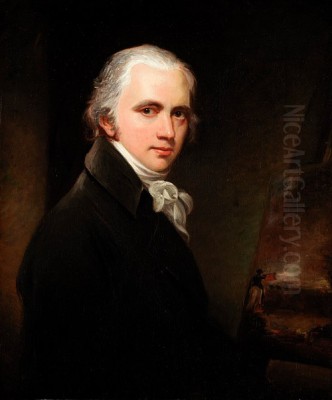
Sir William Beechey stands as a significant figure in the annals of British art history, particularly during the flourishing period often referred to as the Golden Age of British Painting. Active from the late eighteenth century into the early nineteenth, Beechey carved a distinguished career primarily as a portrait painter, favoured by the Royal Family and the upper echelons of society. His life (1753-1839) spanned a time of great change and artistic development in Britain, and his work provides a valuable window into the personalities and fashions of his era.
Early Life and Artistic Awakening
Born in Burford, Oxfordshire, in 1753, William Beechey faced adversity early in life. His parents, a solicitor father and mother Hannah Read, passed away when he was young, leaving him in the care of his uncle, Samuel Beechey. Initially, his uncle intended for him to pursue a career in law, a respectable path for a young man of his standing. However, the pull of art proved stronger for William.
He initially found work, perhaps less glamorously, as a house painter. This practical engagement with pigments and surfaces may have further kindled his innate interest in the visual arts. Demonstrating a clear talent and passion that could not be ignored, he eventually gained his uncle's support to pursue painting seriously. This pivotal decision led him to London, the heart of the British art world. In 1772, he was admitted as a student to the prestigious Royal Academy Schools, marking the formal beginning of his artistic journey.
Forging a Career
The Royal Academy Schools provided Beechey with a formal grounding in artistic techniques and exposed him to the prevailing styles and influential figures of the day. He absorbed lessons from the works of established masters, notably the German-born Johann Zoffany, known for his detailed conversation pieces and theatrical portraits, and the towering figure of Sir Joshua Reynolds, the first President of the Royal Academy.
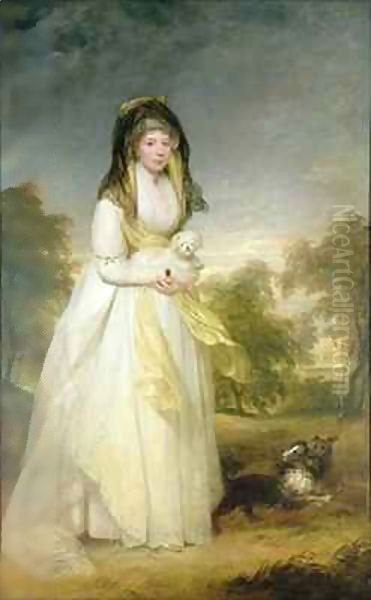
Beechey's style began to coalesce under these influences. He was drawn to the elegance and refinement associated with the Rococo aesthetic, evident in Zoffany's work, favouring delicate handling and an agreeable, often idealized, portrayal of his subjects. From Reynolds, he learned the principles of the 'Grand Manner', though he often adapted them towards a more naturalistic and less overtly dramatic presentation. His approach was generally conservative and consistent, focusing on achieving a good likeness and conveying the sitter's status with decorum. He first exhibited his work publicly in 1776, beginning his long association with the London art exhibitions.
Royal Patronage and Recognition
Beechey's diligence and talent did not go unnoticed. His ability to capture likenesses accurately while maintaining an air of grace and dignity appealed to the tastes of the aristocracy and, crucially, the Royal Family. A major turning point came in 1793 when he was appointed Portrait Painter to Queen Charlotte, the wife of King George III. This prestigious appointment cemented his position within the art establishment and brought him numerous commissions from the highest levels of society.
The same year, 1793, saw his election as an Associate of the Royal Academy (ARA). His ascent continued, and following the exhibition of his large and ambitious equestrian portrait, George III and the Prince of Wales Reviewing Troops (circa 1798), his reputation soared. This work, depicting the King, the Prince of Wales (later George IV), and the Duke of York at a military review, was a significant public success. In recognition of this achievement and his service to the Crown, Beechey was knighted by George III in 1798, becoming Sir William Beechey. This honour was accompanied by his election as a full Royal Academician (RA) that same year, marking the pinnacle of his professional recognition. He became a favoured painter for depicting the royal children, including notable portraits of Princess Sophia and Princess Augusta.
Mature Style and Notable Works
Sir William Beechey's mature style is characterized by its polish, competence, and adherence to established conventions of portraiture. While perhaps less innovative than some contemporaries like Sir Thomas Lawrence, Beechey excelled at producing reliable, flattering, and well-crafted likenesses. His style was seen as solid, dependable, and eminently suitable for the formal requirements of royal and aristocratic portraiture.
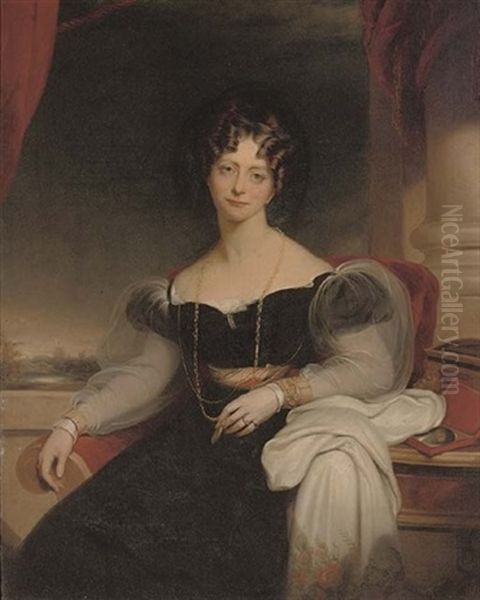
His technique often involved placing his sitters against dark, unobtrusive backgrounds, which helped to emphasize their features and attire. He employed a relatively smooth paint application and paid meticulous attention to the rendering of fabrics, lace, and jewellery, details that conveyed the wealth and status of his clientele. His colour palette was generally harmonious and pleasing, avoiding harsh contrasts. He demonstrated a particular aptitude for painting children, capturing their innocence and individuality, often in charming domestic or informal settings, as seen in works like Two Children with a Spaniel.
Among his many notable works, several stand out. Portraits of royalty, such as Queen Charlotte, Princess Sophia, Princess Augusta, and George IV as Prince of Wales, are central to his oeuvre and reside in significant collections, including the Royal Collection Trust. He also painted prominent figures from the political, military, and cultural spheres, such as the actor John Philip Kemble (1805). Generic titles like Portrait of a Woman (1805) also represent the bulk of his commissioned work, showcasing his consistent skill across numerous society portraits. His large-scale George III Reviewing Troops remains a key work demonstrating his ambition and ability to handle complex group compositions.
Contemporaries and the London Art Scene
Beechey operated within a vibrant and competitive London art world. The late 18th and early 19th centuries were indeed a 'Golden Age' for British painting, especially portraiture. He constantly measured his success against other leading practitioners. His most significant rival was undoubtedly Sir Thomas Lawrence, a younger, more flamboyant painter who eventually surpassed Beechey in fashionable favour, particularly under the patronage of the Prince Regent (later George IV).
Another prominent rival was John Hoppner, with whom Beechey shared the patronage market. Despite their rivalry, there was a degree of professional respect; Hoppner painted Beechey's portrait in 1807, and Beechey returned the favour by painting Hoppner in 1808. Other major figures whose careers overlapped or directly competed with Beechey's included the established masters Sir Joshua Reynolds and Thomas Gainsborough (though Gainsborough died in 1788, his influence lingered). George Romney was another major force in portraiture during Beechey's earlier career.
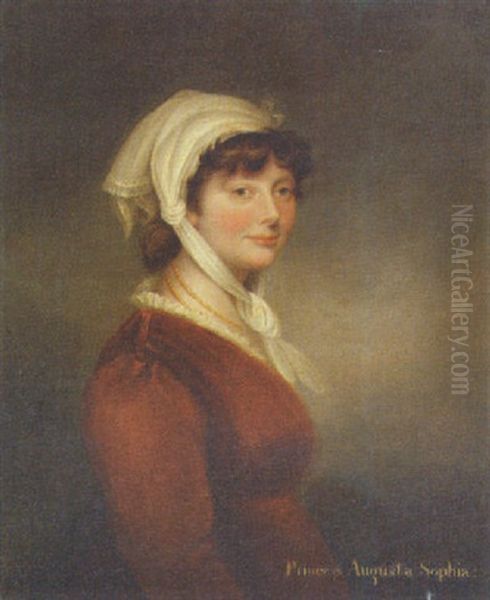
The Royal Academy was the central institution, presided over first by Reynolds and later by the American-born Benjamin West. Beechey would have known fellow Academicians like the Swiss-born Angelica Kauffman, one of the few female founding members, and James Northcote, a pupil of Reynolds. Other contemporaries included the Scottish portraitist Sir Henry Raeburn, the American Gilbert Stuart who worked in London for a period, the miniaturist Ozias Humphry, and his early influence, Johann Zoffany. Beechey also formed a notable friendship with the landscape painter John Constable, offering encouragement and advice to the younger artist, demonstrating connections beyond the immediate circle of portraitists.
Personal Life
Beyond his busy professional life, Beechey maintained a family. He was married twice. His first wife was Mary Ann Jones. After her passing or their separation, he married Anne Phyllis Jessop in 1793. This second marriage appears to have been particularly fruitful. Across his marriages, he fathered a number of children, several of whom followed artistic or adventurous paths.
His son Henry William Beechey (not to be confused with Sir William himself) also became a painter and Egyptologist. Another son, Frederick William Beechey, achieved distinction as a naval officer, explorer, and artist, known for his watercolours documenting Arctic expeditions. A daughter, Frances Anne Beechey, pursued art as a miniature painter, continuing the family's artistic inclinations. This familial engagement with the arts suggests a supportive environment for creative pursuits within the Beechey household.
Later Years and Legacy
Sir William Beechey enjoyed a long and productive career. He remained a stalwart of the Royal Academy, exhibiting his work there almost every year from 1776 until shortly before his death, with a particularly consistent run from 1805 to 1838. While the knighthood in 1798 marked a high point, some sources mention a further honour or confirmation in 1827, though the 1798 knighting linked to the Review painting is the most commonly cited.
As the 19th century progressed, artistic tastes began to shift. The more dynamic and psychologically penetrating style of Sir Thomas Lawrence increasingly captured the public imagination and the favour of patrons like George IV. Beechey's style, while always competent and refined, began to be perceived by some critics as somewhat conservative or lacking in the fashionable flair of his rival. His work was occasionally described as lacking "naturalness," perhaps indicating a preference for a more formal or idealized presentation compared to the growing trend towards Romanticism.
Despite this gradual shift in fashion, Beechey retained considerable respect and continued to receive commissions. He passed away in Hampstead, London, in January 1839, at the advanced age of 85 (the date 1830 and cause mentioned in one source text section appears erroneous based on established biographical data). He was reportedly widely mourned, remembered not only for his artistic talent but also for his personal integrity and honesty.
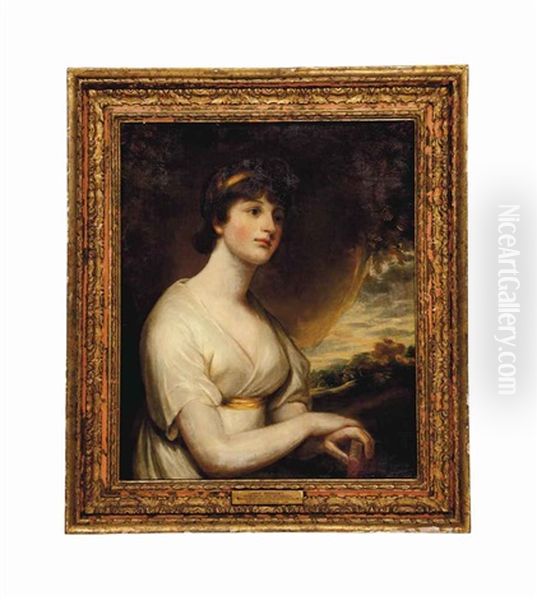
Sir William Beechey's legacy lies in his substantial contribution to British portraiture during a key period. He expertly documented the likenesses of royalty, aristocracy, and notable figures of his time, leaving behind a valuable visual record. His technical skill, particularly in rendering likenesses and textures, was considerable. While perhaps overshadowed in later assessments by the brilliance of Reynolds, Gainsborough, or Lawrence, he remains an important figure, representative of the high standards of craftsmanship and the prevailing tastes of the late Georgian era. His works are held in major museums and collections worldwide, ensuring his continued recognition as a pillar of the British school of painting.
Conclusion
Sir William Beechey navigated the competitive London art world with skill and diplomacy, rising from humble beginnings to become a Knight of the Realm and Portrait Painter to the Queen. Influenced by Zoffany and Reynolds, he developed a reliable, elegant, and highly finished style that perfectly suited the demands of his elite clientele. While his adherence to convention meant his star faded slightly against the rise of more Romantic painters like Lawrence, his output was prolific, his craft impeccable, and his contribution to the Golden Age of British Portraiture undeniable. Through his numerous portraits, Beechey offers us a clear and dignified view of the faces that shaped late Georgian Britain, securing his enduring place in art history.